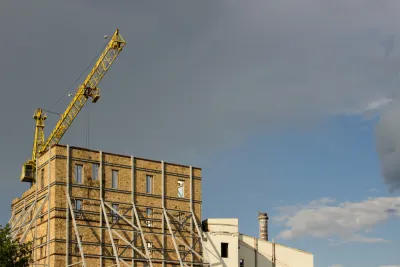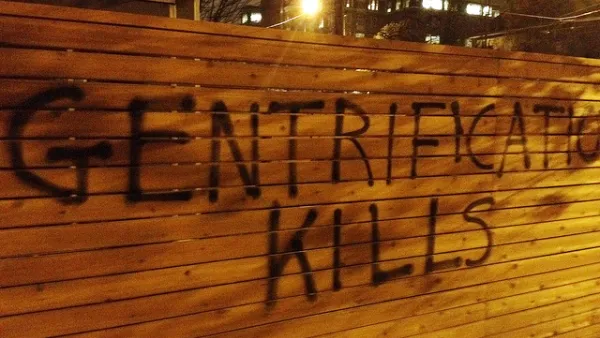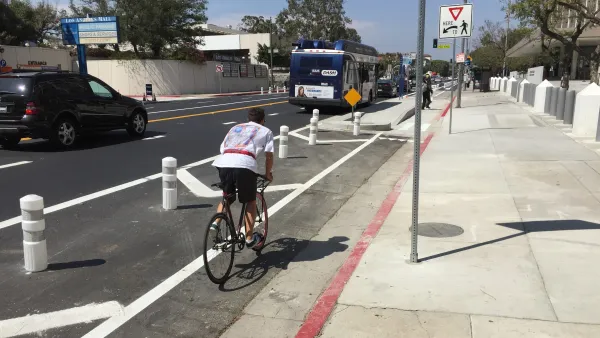Gentrification is apparently quite rare—so why do urban affairs commentators devote so much time arguing about it?

A few months ago, the National Community Reinvestment Coalition (NCRC) issued a widely publicized study on gentrification. The study found that gentrification was "rare" outside the biggest U.S. cities, and that "seven cities accounted for nearly half of the gentrification nationally: New York City, Los Angeles, Washington, D.C., Philadelphia, Baltimore, San Diego and Chicago." In 76 percent of cities, not one Census tract gentrified; in 20 percent more, five or fewer tracts gentrified.
But even in those cities, gentrification occurred in a tiny minority of neighborhoods. For example, in Washington, D.C. (which the NCRC report described as the "most gentrified city") only 62 of the city's 1346 Census tracts gentrified—only 4.6 percent. In New York City, only 144 out of 4515 tracts gentrified—about 3.2 percent. Displacement (which the study defined as a decline in Black and/or Hispanic population) was even more rare. Nationally, displacement occurred in only 22 percent of all gentrifying tracts. In Washington, D.C. (the city with the most displacement) it occurred in 33 tracts, or 2.4 percent of all tracts. In New York, it occurred in only 26 tracts, or less than 1 percent. In San Francisco and Oakland, displacement occurred in only 13 out of 975 tracts. In Atlanta, displacement occurred in only 7 out of 946 Census tracts.
So even according to a progressive community development organization, gentrification and displacement are only slightly more common than the Easter Bunny. So why do scholars and planners write about it so much? I am not sure, but have I three possible explanations.
First, perhaps people who write about gentrification tend to live in gentrifying areas. In my experience, scholars and planners often do not earn enough to live in a city’s traditionally affluent neighborhoods (such as New York’s Upper East Side). Some of these people move to suburbia—but others might be more likely to live in a more affordable neighborhood, which often is a newly gentrifying neighborhood. For example, I live in a part of Midtown that I suspect was affluent before I was born, but many of my friends who are urban planners live in once-poor neighborhoods such as Crown Heights—which is to say, they are arguably gentrifiers themselves.
Second, today city residents tend to be political progressives, and gentrification fits into the Left’s way of looking at the world. Progressives tend to see the rich as oppressors and the poor as oppressed. (By contrast, conservatives tend to see the rich as job creators oppressed by government regulation.) The idea that rich people are kicking poor people out of neighborhoods is one that fits progressives' frame, and so they tend to be much more interested in this scenario than in events that do not fit their frame—for example, stories of bureaucrats oppressing small businesspeople.
Third, sometimes gentrification might be a bad faith argument used by neighborhood activists to keep out housing or stores. Homeowners naturally want to keep the value of their homes high—and the best way to do that is to exclude competitors such as the owners of new housing. But in a politically progressive city, someone who admits that he wants to exclude new housing to keep rents high might seem unprogressive or even racist. So homeowners can clothe their opposition to new housing in progressive language by invoking the threat of gentrification.

Analysis: Cybertruck Fatality Rate Far Exceeds That of Ford Pinto
The Tesla Cybertruck was recalled seven times last year.

National Parks Layoffs Will Cause Communities to Lose Billions
Thousands of essential park workers were laid off this week, just before the busy spring break season.

Retro-silient?: America’s First “Eco-burb,” The Woodlands Turns 50
A master-planned community north of Houston offers lessons on green infrastructure and resilient design, but falls short of its founder’s lofty affordability and walkability goals.

Test News Post 1
This is a summary

Analysis: Cybertruck Fatality Rate Far Exceeds That of Ford Pinto
The Tesla Cybertruck was recalled seven times last year.

Test News Headline 46
Test for the image on the front page.
Urban Design for Planners 1: Software Tools
This six-course series explores essential urban design concepts using open source software and equips planners with the tools they need to participate fully in the urban design process.
Planning for Universal Design
Learn the tools for implementing Universal Design in planning regulations.
EMC Planning Group, Inc.
Planetizen
Planetizen
Mpact (formerly Rail~Volution)
Great Falls Development Authority, Inc.
HUDs Office of Policy Development and Research
NYU Wagner Graduate School of Public Service





























